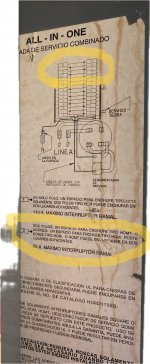hitehm
Senior Member
- Location
- Las Vegas NV
Our problem:
Coming off the roof we have 3 Enphase 20A microinverter circuits landing in the Enphase combiner box, then leaving the combiner box on 1 60A circuit (52.94 actually) through the disconnect and what would normally land on a 60A backfed solar breaker in the MSP. However, the customer's MSP won't allow more than a 50A 2P breaker in the top slots where we need to land our 60A solar breaker.
Possible Solution: (And fyi, we are trying to avoid 2 separate combiner boxes with 2 separate discos)
Place a small 4 slot MLO subpanel after the disco before the MSP and split the one 240V 60A 2P PV circuit into two 240V 30A 2P feeder circuits that will land in the top 2 slots on two 30A backfed breakers in the MSP.
So the questions are:
Is there anything wrong electrically, code wise, safety wise or other that I'm missing?
Coming off the roof we have 3 Enphase 20A microinverter circuits landing in the Enphase combiner box, then leaving the combiner box on 1 60A circuit (52.94 actually) through the disconnect and what would normally land on a 60A backfed solar breaker in the MSP. However, the customer's MSP won't allow more than a 50A 2P breaker in the top slots where we need to land our 60A solar breaker.
Possible Solution: (And fyi, we are trying to avoid 2 separate combiner boxes with 2 separate discos)
Place a small 4 slot MLO subpanel after the disco before the MSP and split the one 240V 60A 2P PV circuit into two 240V 30A 2P feeder circuits that will land in the top 2 slots on two 30A backfed breakers in the MSP.
So the questions are:
Is there anything wrong electrically, code wise, safety wise or other that I'm missing?



